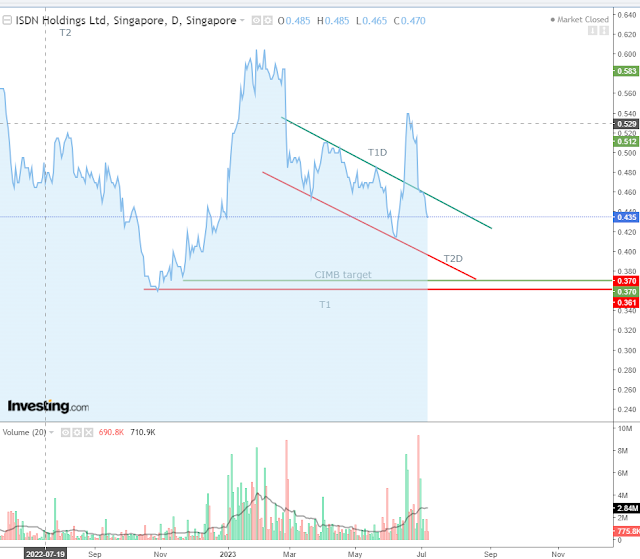10 July 2023
CGS-CIMB, a broker house in Singapore downgraded ISDN to 'reduce' holding on 27 June 2023. They gave a target price of S$0.37. This target price is about 32% lower than the highest closing price of S$55 on 20 June. They were of the view that China's performance will be weak in the coming months. An excerpt of the CIMB report can be found here. It was also summarised in this article.
According to TradingView, ISDN derived about 65% of its revenue from China as shown in the following graph.
As a result, ISDN's share price dropped 9.7% or S$ 0.05 from S$0.515 to S$0.465 on 28 June. It then dropped for the next few trading days to close at S$0.435 on 7 June, about 15% down since the day the counter was downgraded. The price dropped further on poor market sentiment and ended with a price of S$4.35 on 10 July 2023, about 20% down from its recent peak on 20 June 2023.
A question remains as to whether ISDN would go as low as S$ 0.37 as predicted by CGS-CIMB or it would bound and recover quickly from this nasty fall.
About ISDN
ISDN Holdings Ltd is a Singapore company specializing in the provision of automation solutions and services ranging from precision components and engineering services. It provides also specialized Engineering Solutions, Industrial Computing Solutions, and Other services. Off late, it has ventured into renewable energy solutions. A mini-hydro power plant (10 MW) in Lau Biang, Indonesia was completed and commissioned in December 2022. Recently, it said it has obtained permission to commission another 2 mini-hydropower plants in Anggoci (10 MW) and Sisira (4.6 MW), Indonesia. Earlier on, it has associated with a firm called AEnergy which has operated a few hydropower plants elsewhere in Indonesia Presently, the ISDN is still holding about 67% of the stocks in AEnergy according to the 2022 annual report.
About Hydro Power Plant
For those who are not familiar with Hydro Power Plant, here is one good article to read. In short, hydropower can provide a low-cost electricity and green solution as compared to other sources of energy.
Can Hydro Power Help the Bottom Line?
The answer is definitely a yes.
When the ISDN's first hydropower project in Lau Biang was completed and in operation during December 2022, ISDN claimed that this Lau Biang plant would add about 18.5% to the group earnings based on 2022 earnings. This earning is worked out to be around S$2.5 million per year based on the S$15 million annual earnings reported on February 2023. The Lau Biang plant is 10 MW and the 2 extra plants in Anggoci and Sisira will add another 14.6 MW.
By mathematical proportion, It is estimated that the 3 plants will add another S$5 million per year toward the earnings of ISDN. But, there is always a "but" for reasons to be explained.
Reasons
1. Hydro Power Plant constructions are Capital Intensive
Hydro Power Plants are cost-effective projects but a worthwhile investment. It unit cost of development is more than US$2000 per KW. This is almost twice as much as compared to the fossil fuel power plant.
In the US and in other countries where electricity tariff is moderately high, the hydropower plants would have an internal rate of return (IRR) of more than 14%. The payback period is usually within 10 years. But in Indonesia where the electricity tariff is kept low. around US$0.09 per Kwh, the internal rate of return (IRR) is usually less than 10% and the payback period could exceed 10 years.
2. There are certain risks in hydropower plant investment in Indonesia
a) The Government could change the policies under political pressure. Not too long ago in 2020, they put a capacity cap on how much hydropower plants can generate and they buy the excess power only at half price.
b) The power generated is assumed to be sold PLN, the local electricity board. PLN has a Power Purchase Agreement (PPA) that could restrict the sale and change the selling price. This selling price is generally about 85% of the tariff.
Technical Analysis
Technically, we are seeing ISDN trapped in a downward channel which is supposed to be bullish going ahead when the price can break the resistance trendline T1. The CIMB target price of S$0.37 is very close to the support at S1 according to the following weekly chart.
If we zero into the daily chart, we could see that the ISDN price is bouncing between the channel labeled T1D and T2D at the moment. It has broken up but was forced back into the channel by the CIMB price downgrade.
Going ahead, we are expected to see the price to stay within the channel. For information, T2D, marked in red, is one very strong support; breaking it can cause volatile trades. if this T2D support is broken, the ISDN price will want to test the support S1 as shown in the above weekly chart.
The Candlestick Gap
There are 2 candlestick gaps spotted in the ISDN chart. One happened to be on 27 February 2023 and the other, recently, on 28 June 2023.
The one on 27 Feb was created by the ISDN's report about a 42% falls in the annual net profit; the one on 28 June was caused by downgrades from CIMB.
On both occasions, the trading volume on the day was over 5 times the 100-day average daily volume. This volume is significantly large.
According to some textbooks, they can be classified as runaway gaps. It might take months or years to fill.
As these gaps are
earning-related, the gaps could be filled if ISDN can produce a good earning
report to convince the investors. The next half yearly result would be
around September 2023. Hopefully by then, there will be good earning
news.








No comments:
Post a Comment